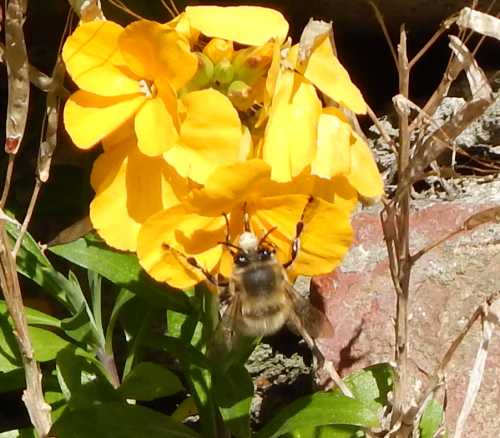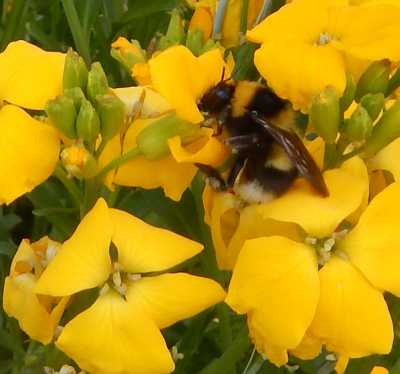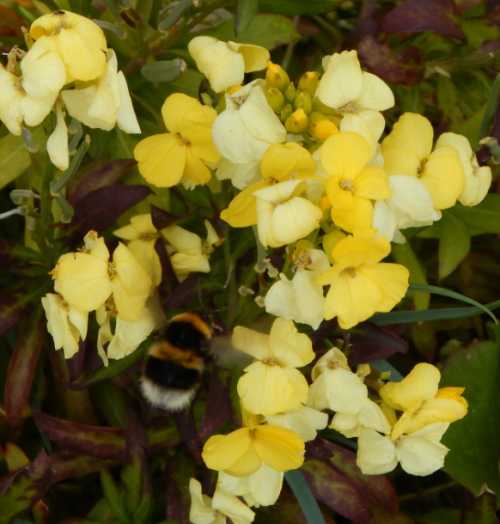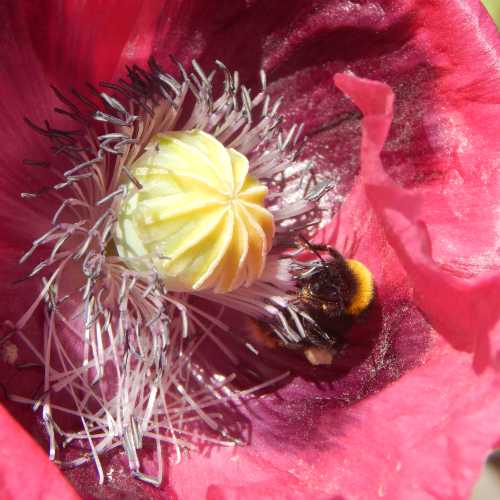Grow Wallflowers (Erysimum) For Bees
I have a small patch of wallflowers in my garden, that I planted specifically for the bees, though I like them too. I also see wallflowers in our local area, growing from nooks and crannies in old walls, and along pavement verges - often being visited by bees.
I have fond childhood memories of walking down a country lane in the village in which I lived, passing a house that had a small strip of soil at the front, filled with wallflowers. Every year, the scent was heavenly, though many of the highly cultivated varieties these days are distinctly lacking in the gorgeous aroma I enjoyed all those years ago.
Which wallflower variety should I plant for bees?
 Above: Long-horned bee - Eucera longicornis (female) on wallflower.
Above: Long-horned bee - Eucera longicornis (female) on wallflower.I purchased my pot of wallflowers from a church plant sale, however, you can grow wallflowers from seed.
If you want to ensure you have fragrance and that bees will visit your wallflowers, it's quite simple really: go for Erysimum cheiri - the Common Wallflower.
They are perennials (short-lived) and evergreen. I love the variety of yellow and orange available.
However, here is a list of bee-friendly wallflowers:
For yellows and oranges:
- Erysimum cheiri
- Erysimum cheiri 'Sunset Primrose'
- Erysimum 'Bredon'
- Erysimum 'Golden Jubilee'
- Erysimum 'Apricot Twist'
- Erysimum 'Walberton's Fragrant Star'
- Erysimum cheiri 'Sunset Apricot'
- Erysimum × marshallii 'Orange Monarch'
For pinks:
- Erysimum 'Bowles's Mauve'
- Erysimum 'Red Jep'
 Above: Largen Garden Bumble Bee - Bombus ruderatus foraging on wallflowers in my garden.
Above: Largen Garden Bumble Bee - Bombus ruderatus foraging on wallflowers in my garden.How to grow Erysimum cheiri for bees
Help to ensure efficiency of foraging by planting them in a 'drift' if you have the space. I have little space, so I have a small patch - still, they are appreciated by the bees.
You'll need full sun. You can sow wallflowers direct into a prepared bed, or cultivate them in pots, then plant them out.
If you have a patch of poor, dry soil in a sunny spot, this would be the ideal place for them.
When in flower, enjoy the fragrance and watch the bees get busy!
 Above: Garden bumble bee - Bombus hortorum (queen) foraging on wallflowers in our allotment.
Above: Garden bumble bee - Bombus hortorum (queen) foraging on wallflowers in our allotment.What do wallflowers provide for bees?
Wallflowers provide pollen and nectar for bees of a range of species, especially bumble bees and various solitary species. I have never seen honey bees on my wallflowers, though have read that honey bees are generally only attracted to large drifts of wallflowers - something I am unable to provide in my small garden.
If you found this page helpful or interesting, I'd really be grateful if you would share it with others - if not this page, perhaps another, such as Gardening For Bees.
Thank you so much :) .
